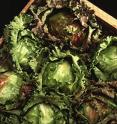Good breeding increases shelf life
The lettuce cut and packaged for food service and salad mixes is an increasingly important component of the produce industry. Lettuce is highly perishable, and the cutting required in processing further shortens its shelf life. Packaging cut lettuce and other fresh produce in semipermeable plastic films extends shelf life via a technique called "modified-atmosphere packaging". The success of modified-atmosphere (MA) packaging for lettuce and certain salad greens has led to innovative products, marketing strategies, and enhanced sales to consumers.
Increased demand for the convenient, pre-cut salads and lettuce has led to scientists to search for ways to select lettuce cultivars that stay fresh, colorful, and crisp. Shelf life and visual quality of salad-cut lettuce are affected by many things, including production environment, vegetative maturity, and type of lettuce chosen. Although an increasing variety of lettuce types are being grown, romaine and "crisphead" (such as iceberg) are the most widely produced for salad-cut products
Ryan J. Hayes, a research geneticist, and Yong-Biao Liu, research entomologist at the U.S. Department of Agriculture's Agricultural Research Service, published the results of a study that should give lettuce breeders and producers enhanced product information and a market edge. During the two-year study, lettuce was processed from field-grown plants of 33 romaine and three "crisphead" cultivars. Shelf life of each cultivar was evaluated after storage in modified-atmosphere bags and in CO2-free controlled-atmosphere chambers.
Lettuce cultivars 'Clemente', 'Darkland', and 'Green Forest' performed consistently well, ranking in the top 10 in every experiment. 'Alpi', 'Dark Green Romaine', and 'Queen of Hearts' showed clearly unstable shelf life. Hayes noted, "cultivars that performed well in our MA environments will likely be useful as parents in breeding programs to develop new romaine cultivars with an acceptable shelf life. It is also clear that not all crisphead cultivars have good shelf life. Wide variation was observed between the crisphead cultivars Pacific, Salinas 88, and La Brillante."
In concluding the impact of the study outcomes, Hayes stated; "Breeders can use these methods to characterize or identify breeding lines that are suitable for salad-cut markets before release, and to select for increased shelf life within breeding populations. These practices should facilitate a consistent release of germplasm with high quality in MA environments."
Source: American Society for Horticultural Science
Other sources
- Good Breeding Increases Shelf Life Of Lettuce And Related Producefrom Science DailyThu, 17 Jul 2008, 19:28:12 UTC
